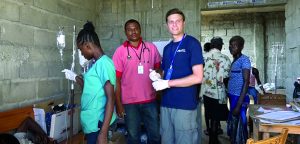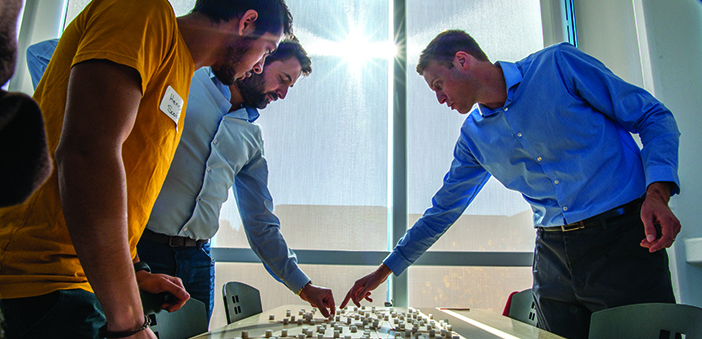Humanitarian workers and academics work together to find best practices—before the next disaster strikes.
In theory, cholera treatment guidelines are pretty simple. Assess how dehydrated the patient is, get their weight and age, do some quick math, and program the IV pump to drip rehydration fluid into their veins. With some antibiotics, even a severely dehydrated patient will be back on their feet in a few days.
But what if you don’t have a scale? Or a calculator? Or, for that matter, an automated drip pump? Suddenly, standards that seem straightforward on paper become extraordinarily difficult to follow in the field.
“That’s something that I wouldn’t have even thought of if I wasn’t there actually doing the work,” Adam Levine, MD, MPH, associate professor of emergency medicine, says of his experience managing a cholera treatment unit in Haiti after Hurricane Matthew tore through last October. “Even though I’ve been doing research and clinical work in cholera for years, it was only in this trip that it really occurred to me what a barrier these specific operational things were.”
The 30-bed cholera treatment unit in Les Anglais, which Levine was managing for International Medical Corps (IMC), faced those very barriers. So he created an Excel spreadsheet on his laptop that calculated the number of drips per minute of rehydration fluid a patient needed based on age and weight, then printed it out and taped it to the wall. Health care workers would estimate a patient’s weight, count the IV drips, and track on a chart how many bags of fluid the patient got.
It was an effective, low-tech solution better suited for a low-resource setting. And it neatly illustrates the disconnect that can arise between academic experts working behind desks and humanitarian professionals on the ground.
“The people who work with humanitarian organizations on a regular basis have all sorts of things like this that they know about, things that they encounter in their regular practice,” says Levine, who with IMC has responded to multiple humanitarian emergencies, including the Ebola epidemic in Liberia and civil wars in South Sudan and Libya.
“The academics who do research, and know how to do research, need to contact the humanitarian professionals to get the ideas and the insights into what are the real … problems they’re having in the field,” he says.
But the two groups sometimes mix about as well as oil and water, says Levine, who published the perspective piece “Academics are from Mars, humanitarians are from Venus” in the journal Clinical Trials last year. On the one hand, he says, many humanitarians have a “blind faith” that “whatever we’re doing must be helping. So why do you need to study it?”
Meanwhile researchers can frustrate even the most receptive humanitarian organizations when they fail to account for the financial and staffing burdens of trial enrollment and data collection in a disaster setting.
An effective emergency response is possible only if these proverbial Martians and Venusians work together. “Humanitarians need the help of academics to be able to develop research studies, or even research with a lowercase ‘r’—monitoring and evaluation—to be able to measure whether the programs that humanitarians are doing are having an impact,” Levine says.
Last fall, Levine launched the Humanitarian Innovation Initiative (HI2) at the Watson Institute for International and Public Affairs at Brown to bridge the academic-humanitarian divide. With seed money from Watson, HI2 is encouraging collaborations between faculty and other professionals from across the University to bring the principles of evidence-based medicine to humanitarian emergency response.
“Dr. Levine has really experienced the challenges of the field—which allows him to know what we’re really suffering in the field,” says Khaled Almilaji, MD MPH’18, a physician from Syria who treated injured protesters after the government crackdown began there; later, from Turkey, he assisted hospitals in opposition-held areas and helped run a polio vaccination campaign in northern Syria. He came to Brown last fall to earn his Master of Public Health.
It’s important for humanitarian organizations “to look at the problem from the outside, what they’re doing now, what are the mistakes, how to do it in a better way,” Almilaji says. “Researchers are the best people to do this in the long term.”
Unintended Consequences
As Levine focused on global health in the MD-MPH program at the University of California’s San Francisco and Berkeley campuses, he became aware “that humanitarian response could actually do harm if it wasn’t done properly,” he says.
“I think the lay perception is that humanitarians rush in and do the best that they can, and anything that they do is great,” he says. “In fact, just like in medicine, we can do harm as well as good. And the key is knowing the difference between the two. And really the only way to do that is through training, experience, and research.”

SHAKEN NOT STIRRED: Melissa Godfrey, left, and Lauren Park make oral rehydration solution at a humanitarian response training workshop last November. Photo by David DelPoio
Levine came to the Warren Alpert Medical School in 2009; the following year he joined IMC’s emergency response team, after the earthquake in Haiti. There he saw firsthand “the unintended consequences of humanitarian aid” when he tried to find an antibiotic in a warehouse where a local hospital was storing tons of donated medical supplies, most of them unsolicited. As he searched he came across stacks of boxes of a prostate cancer therapeutic that was about to expire.
“An entire palette in the warehouse was taken up by something we don’t need, that a pharmaceutical company unloads on us to get a tax write-off, and I can’t find the antibiotic,” Levine says.
During his emergency medicine residency, at Harvard, Levine got involved with the Harvard Humanitarian Initiative, where he learned about efforts to professionalize the humanitarian field. “Previously, it has been very much like the Wild West,” he says: aid workers, untrained in emergency response, would rush into a disaster area and treat and feed and house whoever they could in whatever way they saw fit. But they rarely conducted needs assessment surveys or kept detailed records of what they did, and they took any lessons learned home with them, leaving responders to the next disaster to start virtually from scratch. There was “no effective way, or systematic way, of documenting prior experiences so that people could learn from it in the future,” Levine says.
Dave Polatty, MA, participated in humanitarian operations during his 11 years of active duty as a surface warfare and naval flight officer. Since joining the civilian faculty of the US Naval War College in Newport, where he’s an associate professor, he’s helped plan for potential humanitarian operations and relayed his experiences into teaching and research. In 2010, Polatty assessed the Navy’s mission to Haiti after the earthquake. Like Levine, he saw the repercussions of a haphazard response.
“There was a huge military response from around the world that in hindsight could have been better coordinated,” Polatty says. “Like most major disasters, everything was out of control for the first few days and weeks of the response. No one felt like anyone had control of what was going on down there.” The US military needed to figure out how to respond more efficiently and effectively in the future; rather than reinvent the wheel, he “picked up the phone and called Harvard.” He affiliated with their humanitarian initiative, and in 2015 founded the Civilian-Military Humanitarian Response Program, of which he’s the director, at the Naval War College. The years of work paid off when Hurricane Matthew hit Haiti last fall, and “many of the lessons learned from the earthquake were put in place,” he says.
Polatty and Levine finally met last year, and immediately found common ground. “We’re in this tiny little state and 45 minutes apart on a bad day, and yet we were both coming up with the same conclusions from two totally different angles, which shows you there really is a need,” Polatty says. “I love Adam’s program because he recognizes the need to do true, evidence-based research in the field and bring it back and make it accessible in the classroom to future humanitarian leaders.”
Brown and the Naval War College have a collaborative research agreement that Polatty says is critical for humanitarian research. “If we bring Brown students together with military students … there may be some really neat opportunities to have these future leaders meet one another beforehand, discuss these problems in an academic environment, which is very safe, and begin to build trust between one another, because we know there’s a high probability they’ll be working together in these complex environments,” he says.
Big Tent
For better or worse, medical responders get all the glory when disaster strikes. But humanitarian emergency response needs public health experts to contain disease spread and coordinate vaccination campaigns; engineers to build shelters and treatment units; water, sanitation, and hygiene specialists; anthropologists to work with local communities; political scientists to work with local governments and aid in reconstruction efforts.
Brown has experts in all these areas, with interest and experience in disaster response; HI2 is an attempt to gather them under one umbrella and help them work together.

FRONTLINE RESPONDER: Adam Levine, center, manages a cholera treatment unit in Haiti after Hurricane Matthew. Photo by Yvon Vilius/International Medical Corps
“It’s very easy to get siloed,” says Robert Blair, PhD ’06, the Joukowsky Family Assistant Professor of Political Science and International and Public Affairs. Blair has worked for years in Liberia, including during the Ebola epidemic; at the same time Levine was managing a treatment unit in Bong County, Blair was in Monrovia, trying to understand how government mistrust affected citizens’ willingness to take steps to contain the spread of the virus.
“Just knowing who the other people are at Brown who are doing this sort of work, that’s an incredible value added for me,” says Blair, who is one of the initiative’s affiliated faculty. “Collaborating across these disciplinary lines is tricky, because we come from disciplines that have different standards with different methods, with different target audiences. So I think that will be the next challenge: to see whether this really can spark collaborative ideas.”
HI2 is starting small, organizing talks and workshops; pointing undergraduates to such courses as Human Security and Humanitarian Response, Post-Conflict Politics, and Displacement and Refugees in the Middle East; and collaborating with other institutions.
Last October, Levine and three colleagues from Brown, along with academics, humanitarian workers, and military leaders from across the country, convened in Newport for an intensive workshop on Civilian-Military Humanitarian Response. “It was just two days of discussions about how to create meaningful research questions to advance humanitarian response in the future,” Polatty says. “In two days we made a year of progress because we were all in a room together.” Levine and Polatty are planning to cohost a followup event at Brown this summer, to continue to explore ways civilian and military responders can work together more effectively.
Levine eventually wants to offer humanitarian response training through HI2; last fall he led the first half-day, simulation-based workshop for MD, MPH, and MPA students, based on an undergraduate course he leads in the spring. “We’re going to cram an entire semester’s worth of classes into four hours,” he said by way of introduction. After Levine gave a short lecture, the students worked in interdisciplinary groups of four to devise a needs assessment survey for hurricane survivors, and calculate rates of diarrheal disease and prepare a basic oral rehydration solution using salt, sugar, and limes for a refugee camp.
Participants compared statistical methodology and passionately debated the purpose of and questions for the needs assessment survey. As one group considered asking about satisfaction with camp facilities, Melissa Godfrey, RN MPH’18, whose studies focus on global health policy, reminded them: “This is a needs assessment, not an effort to institute morale or build community. It is hard because there is so much more we want to know than what’s feasible and realistic in a case of an emergency.”
In a debrief over lunch, Levine agreed, advising the right balance between quantitative questions like “do you have shelter?” and more qualitative ones about issues they face finding shelter. “If you ask whether [the shelter is]adequate, the answer will always be no,” he said. “It’s important to pinpoint the actual needs.”
“It was great we had an interdisciplinary workshop where people brought their own expertise to the table,” Lauren SunHye Park MD’19 says later. For example, while she focused on acute health problems for the survey questions, she says her MPH and MPA colleagues “thought of the bigger picture.” She adds: “We prioritize things a little differently. We were able to partition the work by our strengths.”
Park, who hopes to volunteer in disaster settings as a physician, says she valued the emphasis on working in low-resource settings. “That’s a big thing we don’t learn in med school,” she says. “It’s not a cookie cutter for every disaster. You really have to evaluate every situation, because that time is as valuable as treating patients.”
Ideas Into Action
Levine’s experience as a frontline responder and a researcher makes him uniquely qualified to lead HI2. During the Ebola epidemic, he served as director of the Ebola Research Team for International Medical Corps, and played an intermediary role between IMC staff and the NIH, which was launching a randomized controlled trial of an experimental Ebola treatment. He impressed on the researchers the impact their activities would have on IMC’s resources, from water and protective equipment to transportation and accommodations; and explained to aid workers the nitty-gritty details of running a clinical trial, including concepts like randomization.
That’s exactly the type of understanding that HI2 can foster on a larger scale. In addition to receiving training at Brown, humanitarian aid workers affiliated with the initiative, like Khaled Almilaji, advance its mission by sharing what they’ve learned in the field. (“We’re working together and learning from each other,” Levine says. “We learn as much from Khaled as he does from us.”) The initiative is supporting 25 international fellows—nearly all from resource-limited countries affected by disaster—to conduct interdisciplinary, evidence-based research with Brown faculty and students, and then put their findings into action back home.
Some problems researchers tackle will be dramatic—like Levine’s ongoing work to simplify diagnosis of dehydration in cholera epidemics—while others, related to policies and procedures, may seem prosaic. But all will be potentially life-changing for humanitarian responders. Almilaji says streamlining disaster response procedures and reporting, for example, would ease a major burden on local humanitarian organizations in Syria and Turkey, which are “overwhelmed” by the different rules and guidelines of each international NGO from which they get funding and other assistance.
“A huge problem in humanitarian aid is there’s not a tremendous amount of consistency,” Levine agrees. “The same way we worked to improve standardization in medicine,” in the form of national, evidence-based guidelines, “we definitely need something like that in humanitarian work.”
“If they’re speaking the same language, if they have the same criteria, terms, units for their reports, it would be more easy to coordinate and find gaps in the work and fill it quickly,” Almilaji says. “Otherwise those who suffer are the civilians.”
At the end of the day, that’s who both humanitarians and researchers want to help.




